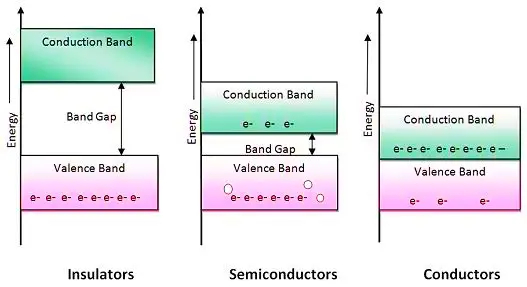Classification of Solids
Classification of Solids
(i) Insulators.
Insulators (e.g. wood, glass etc.) are those substances which do not allow the passage of electric current through them. In terms of energy band, the valence band is full while the conduction band is empty. Further, the energy gap between valence and conduction bands is very large (j 15 eV) . Therefore, a very high electric field is required to push the valence electrons to the conduction band.
For this reason, the electrical conductivity of such materials is extremely small and may be regarded as nil under ordinary conditions. At room temperature, the valence electrons of the insulators do not have enough energy to cross over to the conduction band.
However, when the temperature is raised, some of the valence electrons may acquire enough energy to cross over to the conduction band. Hence, the resistance of an insulator decreases with the increase in temperature i.e. an insulator has negative temperature coefficient of resistance.
(ii) Conductors.
Conductors (e.g. copper, aluminium) are those substances which easily allow the passage of electric current through them. It is because there are a large number of free electrons available in a conductor. In terms of energy band, the valence and conduction bands overlap each other. Due to this overlapping, a slight potential difference across a conductor causes the free electrons to constitute electric current. Thus, the electrical behaviour of conductors can be satisfactorily explained by the band energy theory of materials.
(iii) Semicondutors.
Semiconductors (e.g. germanium, silicon etc.) are those substances whose electrical conductivity lies inbetween conductors and insulators. In terms of energy band, the valence band is almost filled and conduction band is almost empty. Further, the energy gap between valence and conduction bands is very small . Therefore, comparatively smaller electric field (smaller than insulators but much greater than conductors) is required to push the electrons from the valence band to the conduction band. In short, a semiconductor has :
(a) almost full valence band
(b) almost empty conduction band
(c) small energy gap (j 1 eV) between valence and conduction bands.
At low temperature, the valence band is completely full and conduction band is completely empty. Therefore, a semiconductor virtually behaves as an insulator at low temperatures. However, even at room temperature, some electrons (about one electron for 1010 atoms) cross over to the conduction band, imparting little conductivity to the semiconductor. As the temperature is increased, more valence electrons cross over to the conduction band and the conductivity increases. This shows that electrical conductivity of a semiconductor increases with the rise in temperature i.e. a semiconductor has negative temperature co-efficient of resistance.


No comments
Thanks for your Comment.